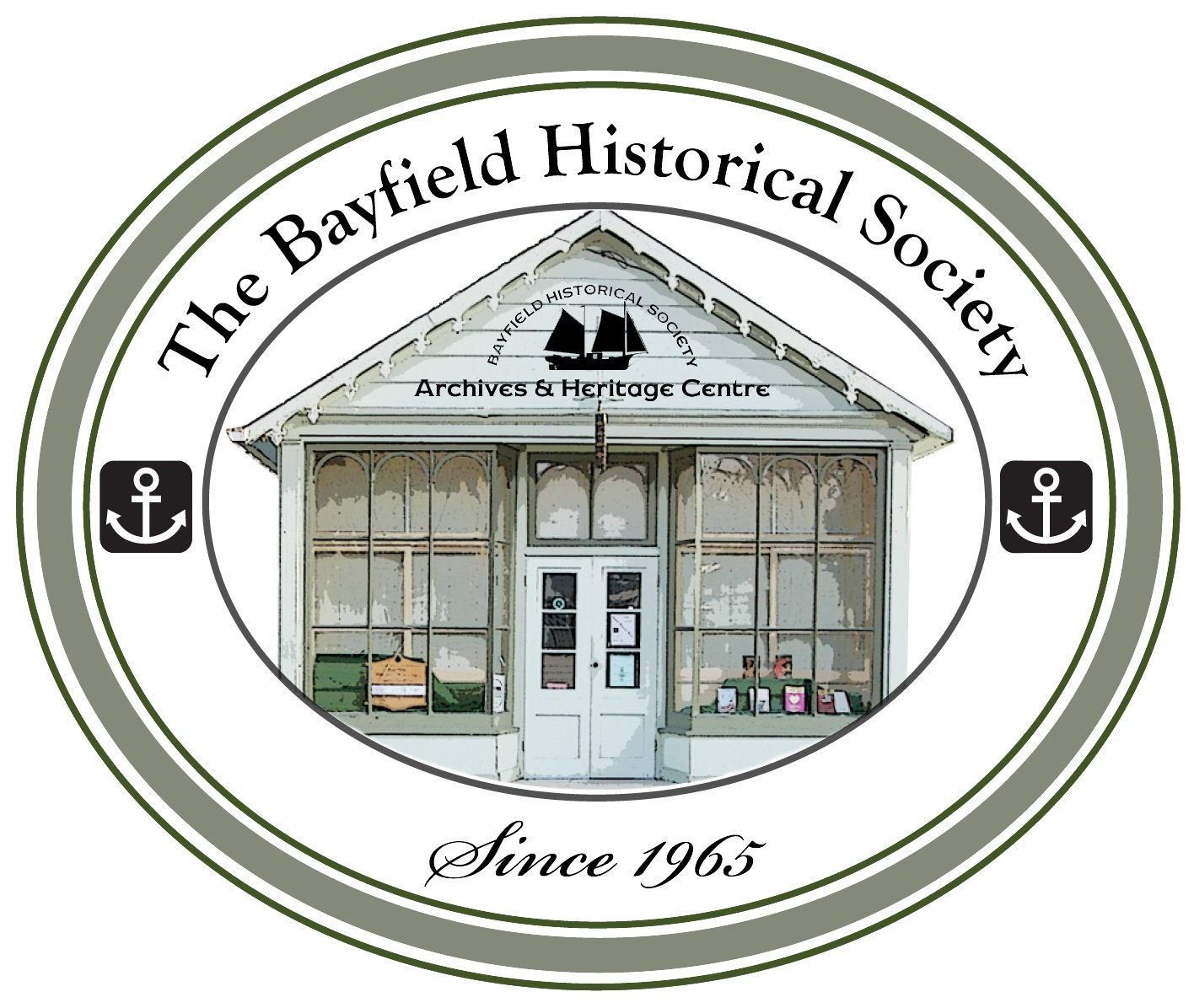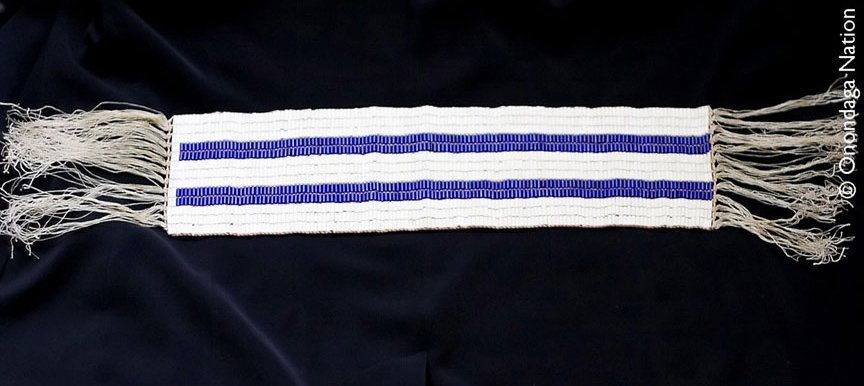Detail of a wampum belt representing One Dish, One Spoon.
“One Dish, One Spoon” and Concepts of Cooperation
The land that Huron County sits upon is founded on the concept of “One Dish, One Spoon” land, which Rick Hill explains very clearly in this short video.
This concept is a fine example of a so called “inter-First Nations” wampum-based treaty. The One Dish, One Spoon concept predates European treaty making and is held to be an ancient idea dating back as far as 900 years ago (Mann). It was formalized at least by the end of the Beaver Wars at the Great Peace of Montreal (1701). According to Lorrie Gallant:
The Dish With One Spoon Wampum uses purple and white beads that represent friendship and peace. The purple “dish” represents the Continent (Turtle Island-Mikinaak Mnising) and all the different Nations. The white centre represents the tail of a beaver, or the resources of this part of Turtle Island. Nations are only to eat from the dish with one spoon, meaning that resources should be shared, each territory should be respected, and nations will not war with each other for the domination of the resources. In this sense, the concept is about respect for the people and animals upon the lands we live upon.
These concepts are being renewed in southwestern Ontario, as environmentally aware generations see it as a foundational principle to Canadian–First Nation treaty making. The concept of “One Dish, One Spoon” is a guiding principle among the Anishinaabeg themselves, and as part of the Covenant Chain with Six Nations and non-Six Nations Iroquois, and successor colonial settler governments in Canada.
Concerning the early foundations of cooperation, “Two Row” principle is also of note. This applies to some of the earliest interactions between Five Nations Iroquois and European contact (between Dutch traders and later English settlers and traders in the early to mid 17th century). In principle, the three most lasting and foundational of the wampum agreements among First Nations people in the northeastern United States and southeastern Canada are the “One Dish, One Spoon,” “Two Row,” and “Friendship Belts” or “Covenant Chains.” All three concepts played important roles in the pre-Confederation treaties in the 19th century, including the Huron Tract Treaty with the Anishinaabeg Nation.
Two-Row Wampum: Two Vessels on One River
The early creation of the two-row wampum is a result of interactions between the Iroquois leaders and Dutch traders in what today is the eastern United States. The principle grew and was referenced as being an important underlying concept of the Great Peace of Montreal in 1701. In the metaphor, there is movement upon the “river of life,” represented by the white belt itself, and two “rows” representing the paths of the canoes of Indigenous peoples and the ships of the Europeans. The two cultures move in parallel along the same river, allowing one another to progress without interference. John Borrows writes that, taken together, the belts “support a notion of citizenship that encourages autonomy and at the same time unifies and connects us to one another, and to the lands we rely on” (Travers, 5).
A two-row wampum.
At a time when First Nations peoples themselves are increasingly aware of the fragility of the land and animals and the role that “lust” for European trade goods played in this complex matrix of associations between land, people, and life ways, the 17th-century concerns are here with us again, only in a different, more pressing way: the concern for the waters. That concern for the waters has been expressed in this decade by water warriors such as Josephine Mandamin and Autumn Peltier. Aaron Mills describes how the One Dish, One Spoon concept applies both historically and today:
There’s a powerful word in Anishinaabemowin that grounds this vision of treaty and this entire discussion: miinigowiziwin.… As individuals, none of us has all the gifts necessary for a good life, minobimaadiziwin; each of us depends on the gifts of others. This is true not just of the sacred gifts… but also of the more mundane gifts the average day calls upon: sacrifice, care, labour, knowledge, skills and abilities....Therefore it’s necessary, for creation to continue, that different kinds of beings (including different human societies) vary as much as we do.... Gete-Anishinaabe (elder) Ken Courchene says: “Look at how we sat in a circle. All differently. We got to sit in this way. Everyone is different and yet equal. And we always had that belief, that difference is not to segregate someone [as] higher or lower” (Mills, 22).
Concerning the fate of the Huron, Petun, and Neutrals (all non-Five Nations Iroquois), the historical record is not absolutely clear. As the Iroquois (Hotinonshonni, Ongwehonwe) scholar Te-ha-ne-torens puts it:
“To read the history... written by non-Indians one is led to believe that all of the Hurons were massacred by the Five Nations, that none were given any quarter, that all died at the stake, etc. In fact, After the Hurons were conquered by the Five Nations in 1650 many were taken in by the Iroquois. Whole villages were adopted by the Senecas and Mohawks. Evidence for this process of wholesale absorption comes not only from the Five Nations own traditions—there is still a surviving ‘Huron Alliance Belt’ from the time—but also from documentary sources. French records for instance, show that in 1657 a party of Five Nations chiefs went to Quebec to persuade nearly 600 Huron refugees to settle among the Mohawks, [and] a decade later Jesuits reported that almost two-thirds of one Iroquois (Five Nations) community were adopted Hurons and Algonquians (Wilson, The Earth Shall Weep, 111).
Sources
Corbiere, Alan. “Their own forms of which they take the most notice': Diplomatic metaphors and symbolism on wampum belts.” In Anishinaabewin Niiwin: Four Rising Winds. Ed. Alan Ojiig Corbiere, Mary Ann Naokwegijig Corbiere, Deborah McGregor, and Crystal Migwans. M’Chigeeng, ON: Objibwe Cultural Foundation, 2014. https://www.researchgate.net/publication/332901083_%27Their_own_forms_of_which_they_take_the_most_notice%27_Diplomatic_metaphors_and_symbolism_on_wampum_belts#pf9
Gallant, Lorrie, Jasmine Wong, Erez Zobary. “The Dish With One Spoon Wampum (Webinar 2),” Facing Canada: a Facing History Community Blog. https://facingcanada.facinghistory.org/the-dish-with-one-spoon-wampum.
Hill, Richard. Voices from Here. In “A Dish with One Spoon.” Canadian Encyclopedia. https://www.thecanadianencyclopedia.ca/en/article/a-dish-with-one-spoon
Jacobs, D. & Lytwyn. “Naagan ge bezhig emkwaan: A Dish with One Spoon Reconsidered.” Ontario History, Vol 112. 2, Fall 2020. https://www.erudit.org/en/journals/onhistory/2020-v112-n2-onhistory05560/1072237ar.pdf .
Mann, Barbara A.; Fields, Jerry L. (1997). "A sign in the sky: dating the League of the Haudenosaunee". American Indian Culture & Research Journal. 21 (2): 105–163. doi:10.17953/aicr.21.2.k36m1485r3062510. [taken from Wikipedia page; track original]
Mills, Aaron. “Nokomis and the Law in the GIft.” Surviving Canada: Indigenous Peoples Celebrate 150 Years of Betrayal, Arbeiter Ring Publishing, 2017.
Travers, Karen. “Seeing With Two Eyes: Colonial Policy, the Huron Tract Treaty and Changes in the Land in Lambton County, 1780-1867.” Dissertation. Toronto: York University, 2015. https://core.ac.uk/download/pdf/77104999.pdf
Wilson, James. The Earth Shall Weep. A History of Native America. Grove/Atlantic, 2000.


